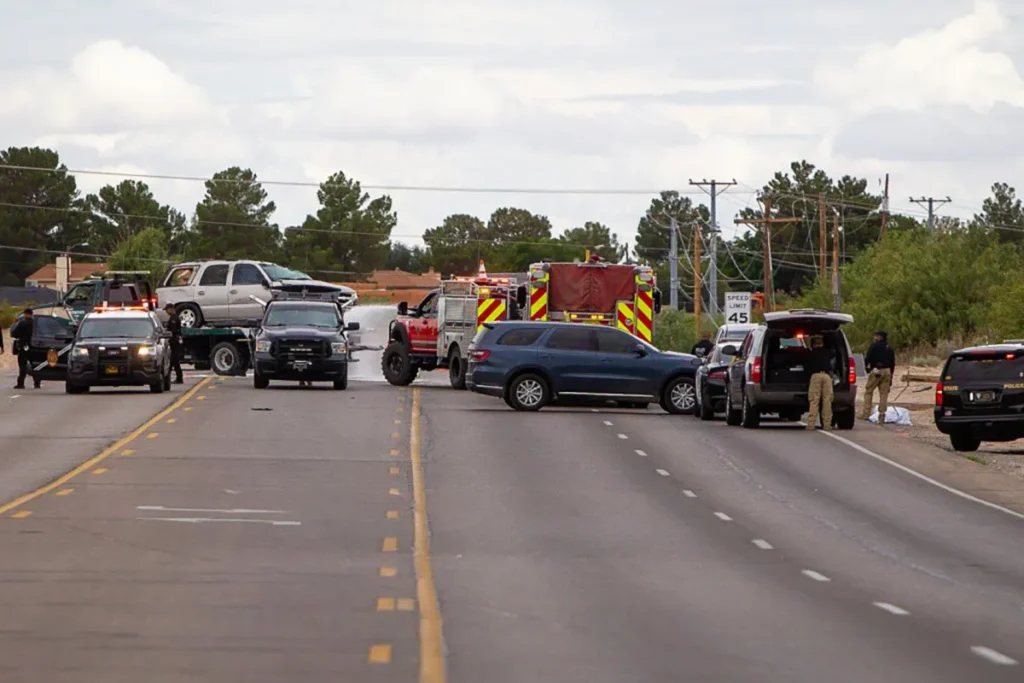‘Severity of crime’ must be considered in Border Patrol pursuits
By Cindy Ramirez for El Paso Matters. January 24, 2023

Come May, border law enforcement agents will be prohibited from engaging in a vehicle pursuit solely on the grounds of a vehicle failing to stop at a checkpoint or yielding to an agent attempting to pull it over.
Instead, Border Patrol agents must consider the “government’s interest” before chasing a vehicle: What’s the severity of the crime believed to have been committed by those involved and the level of the subject’s threat? Additionally, risks to the vehicle’s occupants must also be weighed alongside those to public safety and the agents themselves – a point not previously outlined in guidelines.
Meant to reduce the number of incidents that have led to dozens of deaths, the new Department of Homeland Security pursuit guidelines announced earlier this month are being regarded by migrant and civil rights advocacy groups as a positive first step.
“The policy is a significant improvement on the prior version,” said Rebecca Sheff, senior staff attorney at the ACLU of New Mexico, which is representing several family members of migrants killed during high-speed vehicle pursuits involving the Border Patrol. “The main reason is that it brings CBP into alignment with many best practices across law enforcement about essentially what the rules are for vehicle pursuits.”
While the new guidelines don’t prohibit vehicle pursuits, they do expand on the definition of “objectively reasonable” – and also provide stronger oversight and accountability than years past.
“Critically, this policy does not prohibit pursuits,” U.S. Customs and Border Protection said in a January press release. “CBP’s unique border security mission requires that it retain the ability to pursue vehicles.”
The agency said the policy entrusts agents with the ability to conduct pursuits based on “the severity of the crime and the level of threat posed by the subject and foreseeable risk in their analysis, other available means to apprehend suspects, and the law enforcement need for pursuits.”
Agents may engage in vehicular pursuits if it is necessary and “objectively reasonable” after a vehicle failed to stop at a checkpoint or port of entry, entered the United States at or between a port of entry, or failed to yield when an agent attempted to stop them.
“Objectively reasonable” means agents must consider the severity of the crime at issue not including the mere act of fleeing and whether apprehending the subjects at that time “clearly outweighs” the foreseeable risk to the public, other agents and law enforcement officers and the vehicle occupants.
Sheff said that’s perhaps the biggest change to the policy.
“Agents and officers under the new policy will be asked to assess not only risk of harm to themselves or to the public at large, but also to folks that are occupants of the subject vehicle that’s being pursued,” she said. “That wasn’t really a consideration before.”
Sheff points to one technique that will no longer be allowed under the new guidelines: The PIT maneuver, where an agent’s car strikes the rear of a fleeing vehicle. The precision immobilization technique is supposed to make the fleeing vehicle spin out and come to a stop – a move experts have called highly dangerous at speeds above 35 mph.
More than 90 people died in vehicle pursuits involving the Border Patrol as of Nov. 15, according to the latest figures on the ACLU’s tracker.
Bernardo Rafael Cruz, an attorney with the ACLU of Texas, said the number of incidents involving pursuits in the region doubled from just under 150 in fiscal year 2021 to more than 300 in fiscal year 2022.
“A lot more people got injured during that time and it was very concerning,” he said.
Under the new policies, Cruz said, the default is not to engage in a pursuit unless there’s extreme circumstances.
“If a car is already exceeding the speed limit and is overloaded,” Cruz said. “There’s a greater risk for rollover or accident so that has to be considered.”
Just days before the policy changes were announced this month, a crash involving a Border Patrol pursuit in Santa Teresa in southern New Mexico killed two people and injured eight others. Customs and Border Protection in a statement called the crash a “human smuggling incident.”
A 2019 study by ProPublica found that nearly one in three border patrol car chases ends in a crash. The nonprofit news organization, together with the Los Angeles Times, reviewed the pursuit policies of police departments in the five largest U.S. cities and a dozen jurisdictions in the states that touch the border: All but one were more restrictive than the Border Patrol’s guidelines.
“CBP until now has had pretty lax policies that pose a serious risk of harm to border communities and also were out of keeping with the other practices across law enforcement,” Sheff said.
Read full article on El Paso Matters
https://elpasomatters.org/2023/01/24/border-patrol-vehicle-pursuit-policy-goes-into-effect-in-may/